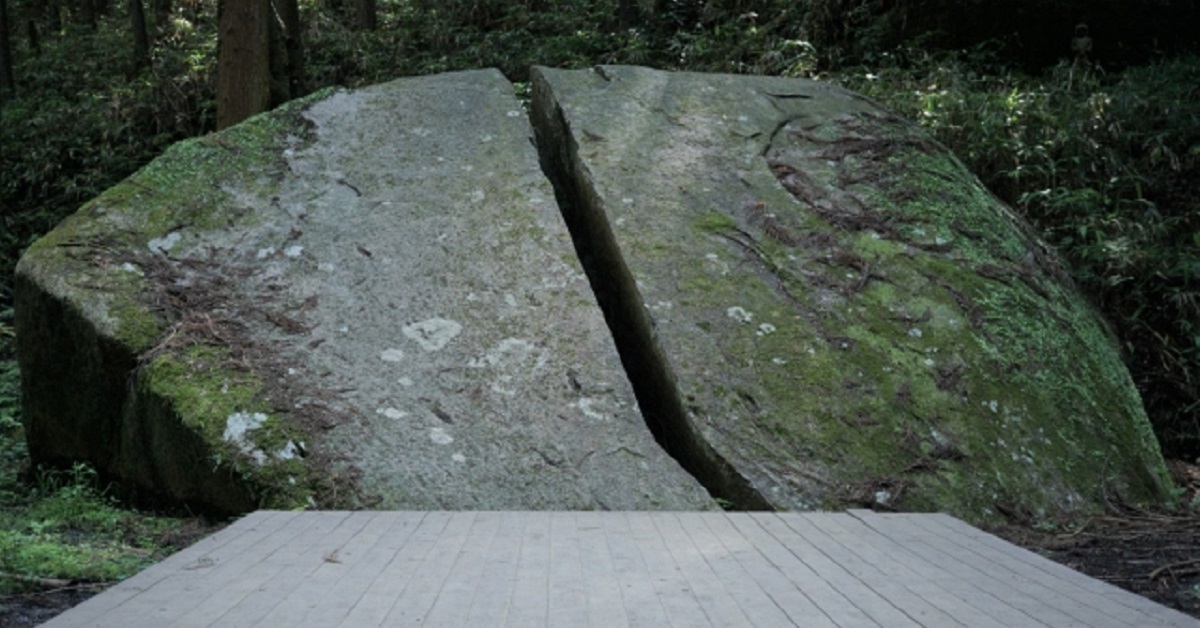The sacred object Ittoseki at Amanoiwatate Shrine in Nara is said to closely resemble the rock from Demon Slayer’s iconic training scene. Revered as a spiritual site, it symbolizes Tanjiro’s growth and offers visitors a blend of history, legend, and inspiration.
- The Origins of Amanoiwatate Shrine and Ittoseki
- Why Demon Slayer Fans Are Drawn Here
- Access and How to Visit
- The Power of Ittoseki as a Symbol of Training
- Sightseeing Around Yanagyu, the Village of Swordsmen
- Tips for Visiting Safely
- A Model Itinerary for Pilgrims
- Checklist of Essentials for the Visit
- Seasonal Highlights
- Conclusion
The Origins of Amanoiwatate Shrine and Ittoseki
Amanoiwatate Shrine has long been revered as a place of worship, believed to bring blessings for martial arts mastery and victory in competitions.
Its sacred object, Ittoseki, is an enormous rock measuring about two meters high and seven meters wide, split cleanly down the middle. While the crack is believed to be caused by natural forces, its razor-sharp division looks as if it were cut by a sword, giving it a mystical aura.
Legend has it that the famous swordsman Yagyu Sekishusai (Muneyoshi) once faced off against a tengu, slicing the rock in two with a single stroke. This legend resonates with the training scene in Demon Slayer, leading many fans to visit the shrine as a pilgrimage site.
Why Demon Slayer Fans Are Drawn Here
Tanjiro’s final trial during training was to cut through a massive boulder. The resemblance between that boulder and Ittoseki makes visitors feel as if the fictional scene has manifested in reality.
Ways fans enjoy the site:
| Activity | Details |
|---|---|
| Photography | Recreating poses with a sword in front of the rock |
| Prayers | Wishing for success in challenges and personal growth |
| Collecting | Obtaining shrine stamps and souvenirs |
The site’s popularity has spread further through social media, especially among younger generations.
Access and How to Visit
Amanoiwatate Shrine is located deep in the mountains of Nara City, requiring some planning to reach.
| Access | Details |
|---|---|
| Train | About 1 hour by bus from Kintetsu Nara Station toward Yanagyu |
| Car | About 30 minutes from Ogura IC on the Meihan Expressway |
| On Foot | About 30 minutes uphill from Yanagyu bus stop |
Visiting steps:
- Pay respects at the shrine
- Walk further along a mountain path
- Encounter Ittoseki deep in the forest
The trail can be uneven, so proper shoes and clothing are essential.
The Power of Ittoseki as a Symbol of Training
Standing before it, visitors are overwhelmed by its presence. The sharp crack, seemingly impossible for nature alone, symbolizes determination and perseverance.
Visitor impressions:
| Visitor Type | Comments |
|---|---|
| Student | “It motivated me to keep studying for exams.” |
| Athlete | “I gained courage to continue training.” |
| Demon Slayer Fan | “It felt like reliving Tanjiro’s training scene.” |
For many, the rock serves as a place to reflect on their own challenges.
Sightseeing Around Yanagyu, the Village of Swordsmen
Yanagyu is known as the “Village of Swordsmen,” home to many historical sites.
| Spot | Highlight |
|---|---|
| Yanagyu Historical Walk | Old residences and landmarks linked to famous swordsmen |
| Hotokuji Temple | Family temple of the Yagyu clan, with the grave of Yagyu Jubei |
| Yanagyu Martial Arts Museum | Exhibitions on the history of swordsmanship |
The area is also blessed with nature: cherry blossoms in spring, lush greenery in summer, vibrant autumn leaves, and serene snow in winter.
Tips for Visiting Safely
Visiting requires preparation and etiquette.
| Caution | Details |
|---|---|
| Footwear | Wear sneakers or hiking boots |
| Weather | Be cautious after rain as the path gets slippery |
| Manners | Take trash home and maintain the shrine’s tranquility |
During peak tourist seasons, visiting early in the morning allows a quieter experience.
A Model Itinerary for Pilgrims
For fans who want a full-day experience, here is a recommended itinerary:
| Time | Activity |
|---|---|
| Morning | Travel from Nara City to Yanagyu by bus |
| Midday | Visit Amanoiwatate Shrine and Ittoseki |
| Afternoon | Explore Yanagyu’s historical sites and enjoy local lunch |
| Evening | Visit Hotokuji Temple, then return home |
Combining the shrine visit with nearby history enriches the pilgrimage experience.
Checklist of Essentials for the Visit
Here are useful items to bring when visiting for the first time:
| Item | Reason |
|---|---|
| Comfortable shoes | Necessary for mountain trails |
| Drinks | Stay hydrated during the walk |
| Camera | Capture memorable moments at the sacred site |
| Rain gear | For sudden weather changes |
Many visitors bring cameras or smartphones to take photos recreating Tanjiro’s training scene.
Seasonal Highlights
The shrine and Ittoseki reveal different charms throughout the year.
| Season | Highlights |
|---|---|
| Spring | Fresh greenery and cherry blossoms |
| Summer | Shaded paths and cool forest atmosphere |
| Autumn | Brilliant fall foliage around the rock |
| Winter | Quiet, mystical snow-covered scenery |
Each season offers a unique atmosphere, making repeat visits worthwhile.
Conclusion
Amanoiwatate Shrine in Yanagyu, Nara City, is renowned for its sacred object, Ittoseki, which strongly resembles the boulder cut by Tanjiro in Demon Slayer.
The rock is more than a tourist spot—it is a symbol of perseverance and personal challenge, inspiring students, athletes, professionals, and fans alike.
By standing before Ittoseki, visitors not only relive Tanjiro’s training but also gain strength to face their own challenges.
This sacred site, where history, nature, and story converge, offers both inspiration and spiritual renewal.






